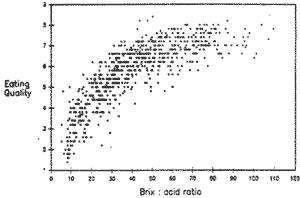From the Archives
of the Rare Fruit Council of Australia
by S .J. R. Underhill and L. S. Wong

A Maturity
Standard for Lychee
Scientific
name: Litchi
chinensis
Family:
Sapindaceae
1. Introduction
As
fruit mature they undergo a complex series of physiological changes,
which dramatically alter their physical and biochemical properties
(Nills et al., 1981; Paull et al., 1984). The assessment and subsequent
correlation of such changes constitute the principal framework of
postharvest maturity standard research. Depending on the end-use of the
fruit and its specific quality attributes, some factors will have a
greater practical relevance (Wills et al., 1981). Potential indices
should be highly correlated to fruit quality either directly or in a
secondary manner and display minimal cultivar variability and seasonal
consistency.
Lychee maturity is of major concern to the
Australian Industry (Menzel et al., 1988). In the absence of maturity
regulations, immature fruit are being sold on the commercial markets.
Although returns are initially high, poor quality and reduced product
reputation dramatically lower subsequent seasonal prices (Sing and
Tomes, 1987). When this is combined with the high incidence of 'first
buyers' and product competition, the damage caused by retailing
immature fruit is severe (Greer, 1989).
With rapidly increasing
production (Sing and Tomes, 1987, Menzel et al., 1988) the industry has
to expand product demand if price is to be maintained. The assurance of
fruit quality through maturity and grade standards would help alleviate
this problem to a great extent.
A wide variety of parameters
have been previously trialled (Brown et al., unpub; and Batten 1986),
with both Brix:Acid ratio and titratable acidity shown to have good
potential (Brown unpublished) as maturity standard parameters.
2. Discussion
The
Brix:Acid ration level of the pulp is calculated from both Total
Soluble Solids (Sugars) and titratable Acidity (Acids). As fruit
mature, their sugar content increases and the acidity level is reduced.
The resultant effect is a logarithmic increase in the Brix:Acid ratio
(Figure 1). The relationship between eating quality and brix: acid
ratio depends on the stage of fruit development. Prior to obtaining
full maturity, large changes in the Brix:Acid ratio account for
relatively small maturity differences. On obtaining full maturity, the
reverse situation occurs. If fruit are overmature or are beginning to
senesce, the Brix:Acid ratio decreases. This is caused by reduced sugar
levels through enzymatic breakdown.
Although eating quality is
dramatically affected by both sugar and acid levels, other parameters
are also involved. Texture, flavour and the presence of off-tastes are
all an integral part of overall eating quality. As a consequence of
these factors, the correlation between eating quality and Brix:Acid
ratio cannot be absolute, and some error must exist. In addition to
this inherent inaccuracy, difference created by both cultivar type,
growing region and possibly seasonality will compound this variability.
Although the relationship between Brix:Acid ratio is subject to all the
above sources of error, compared to other tested parameters, it gave
the best and most consistent correlation.
A. Threshold
Value
The
most important component of a maturity standard is the resultant
threshold or minimum value. It is this process to which most of the
concern is directed. The decision of where a minimal standard will lie
should be the responsibility of the industry. In other crops, a
recommendation has been put forward for adoption without active
involvement of the Industry. The result is constant debate, requests
for further work and general dissatisfaction. The recent situation with
the Mango industry provides a good example.
There is no benefit in
maintaining this approach as problems are sure to develop. By involving
Industry in the developmental stages of maturity standard and allowing
them to subsequently select the maturity standard, such problems will
be reduced. To the pessimist, this may seem like a relinquishment of
one's responsibility. However we feel that if the industry as a whole
develops a standard, the interest of all parties will be served, and
the potential of the standard enhanced.
3. Summary
The
Brix:Acid Ratio of the pulp is highly correlated to eating quality of
the fruit. There is little evidence that cultivar variability, growing
conditions, seasonality or culture practices have a major impact on the
nature of this relationship. Some variability was observed, and should
be considered In the ultimate selection of a threshold value.

Figure 1. Brix:Acid ratio versus eating quality
of Lychee for all cultivars and regions.
The
acidity of the pulp was suggested as an alternative index of maturity.
Our work supports the fact that Acidity and mean eating quality are
well correlated . The potential of Acidity, however, is diminished by
possible seasonal variability.
The Brix:Acid Ratio has some
potential for use by the growers directly as an index for harvesting.
It is suggested that skin colour, titratable acidity and general
appearance should be considered as possible harvest indices. However
consideration of the limitation involved should be addressed.
The Brix:Acid Ratio of the pulp is recommended for use as a Maturity
Standard for Lychee on the commercial markets.
Back to
Lychee Page
|
|


